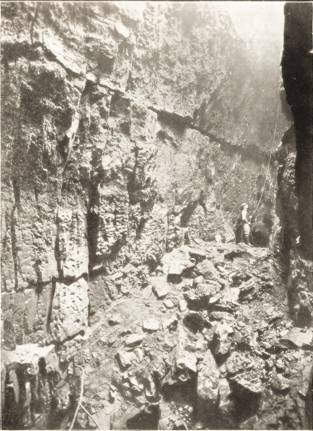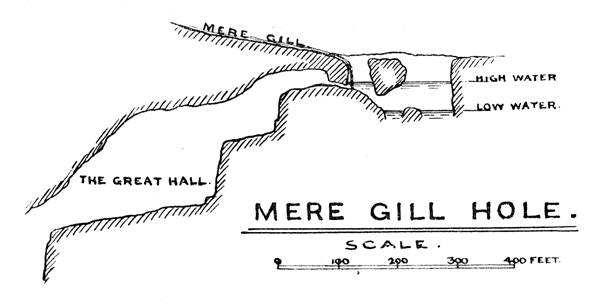Mere Gill Hole
By E. E. Roberts.
Mere Gill is the beck which gathers in the northern cove between Simon Fell and Ingleborough, and at about 1¼ miles from the Hill Inn falls into a rift with a mysterious pool of varying level at the bottom. In dry weather, when this pool is low, gravel can be seen at the foot of the waterfall, which is about 40 feet high, and a fair number of men have climbed down thus far, entered a side-hole under the fall and explored the passage within. At first this passage is low and rises slightly, but suddenly the height increases greatly, the floor begins to slope downwards and at about 100 feet in there is a sudden drop. Only one party is known to have descended this pitch.
At Whitsuntide, 1908, Messrs. Payne, Hoessly, Oechlin, Boyd and Roberts made further progress. In spite of some rain the pool was falling steadily during the two days’ work, but the underside of the great mass of rock which spans the middle of the rift, and at low water is seen to form a bridge, was never revealed. The beck was in its normal condition and the party descended where it enters the rift. The waterfall over the cavern I entrance was dry. Inside, the waterfall on the left of the straight and roughly horizontal gallery was also found dry; that at the end was still flowing. This water follows a short zigzag passage to the left and falls into a deep shaft.
A beam was fitted over this shaft in convenient natural seatings, a pulley rigged up, and the party descended with the aid of a fixed rope and a safety line passed over the pulley. There is a broad ledge two thirds the way down, and the total depth of the shaft is perhaps 60 feet. Round a very sharp corner dry standing ground is reached in a small chamber. The stream continues down an extremely lofty but very narrow zigzag passage which ends in another big drop. One stands here in a small opening high up at the end, below the roof of a huge chamber of limited width but unknown length. The further descent of 80 to 100 feet has to be made in the water, and the party manipulating the ropes is compelled to stand right back round the first corner. The limited working space thus causes considerable risk of the ropes, getting twisted together. Some 20 feet down this second pitch is a fairly wide ledge, and beneath an undercut rift it is possible to relight a candle temporarily. The rest of the descent is freely provided with pinnacles which catch any knot or loop there may be in the ropes. A rise in the stream and a recollection of the doubtful weather sent our party quickly back to the surface.
Returning on Whit Monday, two men were again sent down the second pitch. The narrow floor of the chamber appears at first to be level, but the water has cut deeply below this. A steep pitch was descended, and a straight narrow passage, of even width and containing very deep pools, was followed steeply down for a length of 300 feet to a third great drop, in face of which again nothing further could be done.
In the night of July 4th, another attack was made with strong reinforcements. The pool was extraordinarily low and the underside of the great bridge clearly visible. Thirteen men descended the first pitch, but much time was lost in trying to improvise pulley gear at the second. Five men reached the head of the third pitch, and two were lowered to a ledge some distance beneath. Below l there appears to be a very vertical drop of at least 50 feet, with a pool at the bottom.
The cavern is remarkably clean and the rock solid. Its general direction is into the mountain, the reverse of the surface stream. A party attacking the hole should be prepared to be soaked for many hours; they should number at least eight for working the ropes; and some efficient means should be devised for maintaining a light down the very wet second and third pitches. No exact measurements were taken during the expedition, but the end of the passage cannot be less than 250 feet below the top of the hole.
The accompanying vertical section is little more than an impression of the cave, and is not to be supposed accurate.


